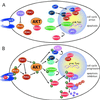AKT plays a central role in tumorigenesis - PubMed (original) (raw)
Review
AKT plays a central role in tumorigenesis
J R Testa et al. Proc Natl Acad Sci U S A. 2001.
No abstract available
Figures
Figure 1
Phosphorylation by AKT regulates compartmentalization of multiple substrates involved in cell cycle progression and inhibition of apoptosis. (A) In serum-starved cells, the pro-apoptotic transcription factors of the forkhead family and cell cycle inhibitors p21 and p27 localize in the nucleus, whereas the oncoprotein Mdm2 is restrained in the cytoplasm. (B) After growth factor (GF) stimulation and phosphorylation by AKT, the subcellular localization of these AKT substrates is diametrically changed, contributing to cell cycle progression and inhibition of apoptosis. Cytoplasmic p21 can bind to the apoptosis signal-regulating kinase (ASK1), inhibiting apoptosis. In the absence of p19/p14ARF induction, the Mdm2-p53 complex shuttles into the cytoplasm where p53 is ubiquitinated (Ub) and targeted for degradation.
Comment on
- A phosphatidylinositol 3-kinase/Akt pathway promotes translocation of Mdm2 from the cytoplasm to the nucleus.
Mayo LD, Donner DB. Mayo LD, et al. Proc Natl Acad Sci U S A. 2001 Sep 25;98(20):11598-603. doi: 10.1073/pnas.181181198. Epub 2001 Aug 14. Proc Natl Acad Sci U S A. 2001. PMID: 11504915 Free PMC article.
References
- Bellacosa A, Testa J R, Staal S P, Tsichlis P N. Science. 1991;254:274–277. - PubMed
- Ahmed N N, Franke T F, Bellacosa A, Datta K, Gonzalez-Portal M E, Taguchi T, Testa J R, Tsichlis P N. Oncogene. 1993;8:1957–1963. - PubMed
Publication types
MeSH terms
Substances
LinkOut - more resources
Full Text Sources
Other Literature Sources
Medical
Miscellaneous
